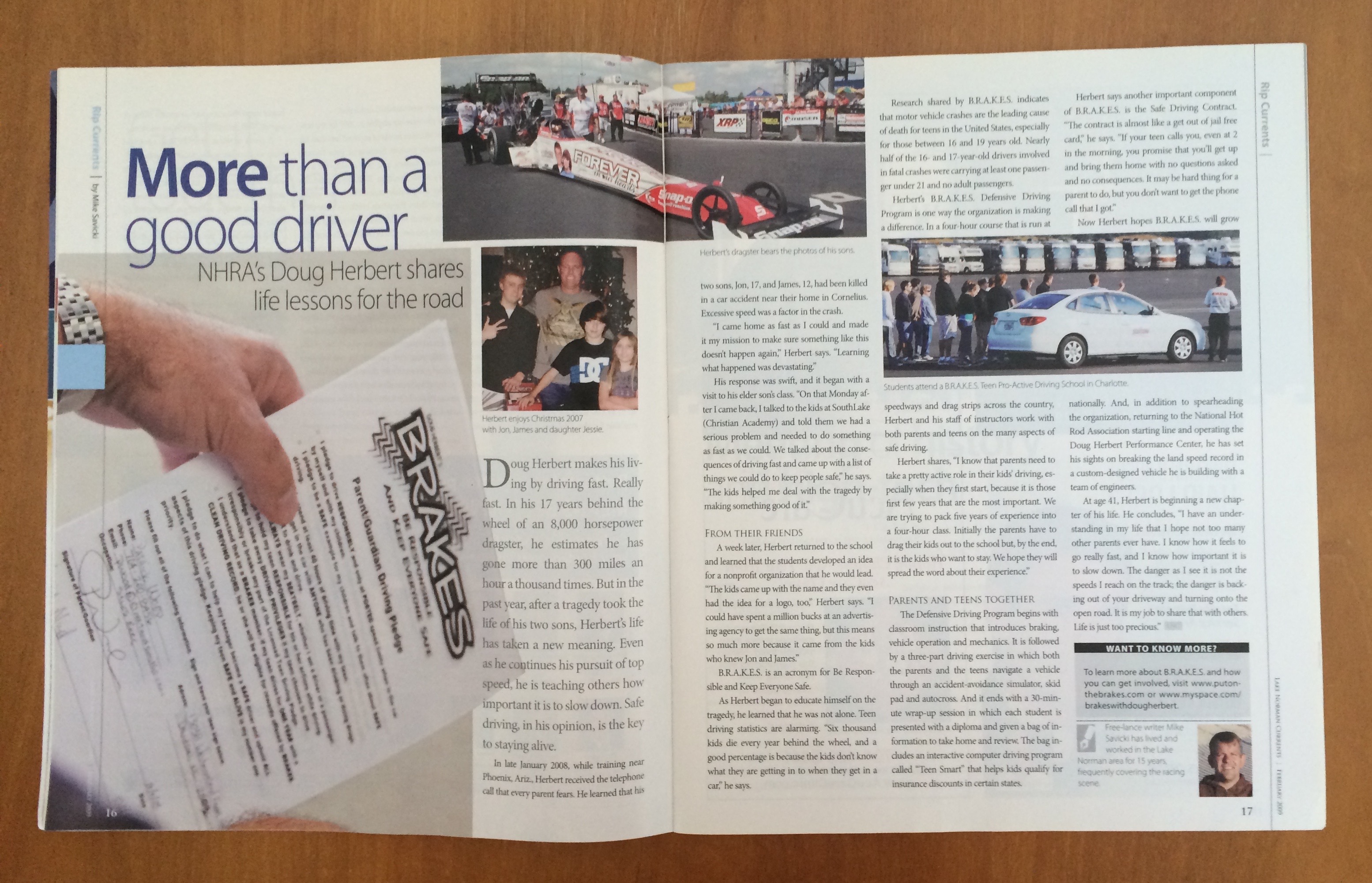More Than a Good Driver
NHRA Top Fuel Driver Doug Herbert shares life lessons for the road
By Mike Savicki
Doug Herbert makes his living by driving fast. Really fast. In his seventeen years behind the wheel of an 8,000 horsepower dragster, he estimates he has gone over three hundred miles an hour literally a thousand times. But in the last year, after a tragedy took the life of his two sons, Herbert’s life has taken a new meaning. Even as he continues his pursuit of top speed, he is teaching others how important it is to slow down. Safe driving, in his opinion, is the key to staying alive.
In late January 2008, while training near Phoenix, Arizona, Doug Herbert received the telephone call that every parent fears. He learned that his two sons, Jon, 17, and James, 12, had been killed in a car accident near their home in Cornelius. Excessive speed was a factor in the crash. “I came home as fast as I could and made it my mission to make sure something like this doesn’t happen again,” Doug Herbert offers. “Learning what happened was devastating.”
His response was swift, and it began with a visit to his eldest son’s class. “On that Monday after I came back, I talked to the kids at SouthLake and told them we had a serious problem and needed to do something as fast as we could. We talked about the consequences of driving fast and came up with a list of things we could do to keep people safe,” he adds. “The kids helped me deal with the tragedy by making something good of it.”
A week later, Herbert returned to the school and learned that the students developed an idea for a non-profit organization that he would lead. “The kids came up with the name and they even had the idea for a logo, too,” says Doug Herbert. “I could have spent a million bucks at an advertising agency to get the same thing, but this means so much more because it came from the kids who knew Jon and James.” B.R.A.K.E.S. is an acronym for Be Responsible and Keep Everyone Safe.
As Herbert began to educate himself on the tragedy, he learned that he was not alone. Teen driving statistics are alarming. “Six thousand kids die every year behind the wheel and a good percentage is because the kids don’t know what they are getting in to when they get in a car,” he says.
Research shared by B.R.A.K.E.S. indicates that motor vehicle crashes are the leading cause of death for teens in the United States, especially for those between 16 and 19 years old. And while young drivers under the age of 24 represent only fourteen percent of the total number of drivers on the road, they account for nearly 30 percent of the total cost of motor vehicle injuries. Nearly half of the 16 and 17-year old drivers involved in fatal crashes were carrying at least one passenger under 21 and no adult passengers.
Doug Herbert’s B.R.A.K.E.S. Defensive Driving Program is one way the organization is making a difference in its first year. In a four-hour-long course that is run at speedways and drag strips across the country, Herbert and his staff of instructors work with both parents and teens on the many aspects of safe driving. Herbert shares, “I know that parents need to take a pretty active role in their kids’ driving, especially when they first start, because it is those first few years that are the most important. We are trying to pack five years of experience into a four hour class. Initially, the parents have to drag their kids out to the school, but by the end, it is the kids who want to stay. We hope they will spread the word about their experience.”
The Defensive Driving Program is comprised of three components. The course begins with a classroom instruction session that introduces braking, vehicle operation and mechanics. It is followed by a three-part driving exercise in which both the parents and the teens navigate a vehicle through an Accident Avoidance Simulator, Skid Pad and Autocross. And it ends with a thirty minute wrap-up session where each student is presented with a diploma and given a bag of information to take home and review. Contained in the bag is an interactive computer driving program called Teen Smart that helps kids qualify for insurance discounts in certain states.
Doug Herbert says that another important component of B.R.A.K.E.S. is the Safe Driving Contract. “The Contract is almost like a get out of jail free card,” says Herbert. “If your teen calls you even at two in the morning, you promise that you’ll get up and bring them home with no questions asked and no consequences. It may be a hard thing for a parent to do, but you don’t want to get the phone call that I got.”
In its first year, one hundred fifty teens and their parents completed the Defensive Driving Program and hundreds more signed the Safe Driving Contract. Looking ahead to 2009, Doug Herbert is hopeful that B.R.A.K.E.S. will grow nationally. And in addition to spearheading the organization, returning to the NHRA starting line and operating the Doug Herbert Performance Center, he has set his sights on breaking the land speed record in a custom designed vehicle he is building with a team of engineers.
At age 41, Doug Herbert is beginning a new chapter of his life. He concludes, “I have an understanding in my life that I hope not too many other parents ever have. I know how it feels to go really fast and I know how important it is to slow down. The danger, as I see it, is not the speeds I reach on the track; the danger is backing out of your driveway and turning onto the open road. It is my job to share that with others. Life is just too precious.”
This article was originally published in the February 2009 edition of Currents Magazine.

